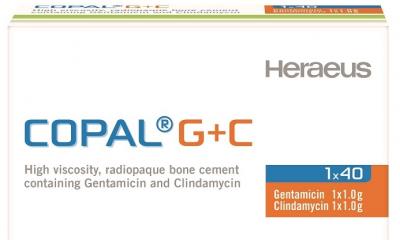Infection control
Topical antibiotic therapy is an indispensable add-on
Locally applied antibiotics are a component of effective infection management in orthopaedics and trauma surgery. Successful concepts are based on patient-specific surgical and antimicrobial treatment. At the symposium “Infections and high-risk patients: solutions for joint replacements and traumatology” at this year’s Congress on Orthopaedics and Trauma Surgery (DKOU) in Berlin last October, two experts discussed the best possible delivery of topical antibiotics.

Any orthopaedic or trauma surgery intervention can cause an infection – a risk which is particularly high when a foreign object remains in the patient’s body, be it as a spacer or as the actual implant, as bacteria are prone to colonize the surface of objects. Thus, antibiotic therapy for infection prophylaxis is generally considered indispensible in orthopaedics and trauma surgery, above all in high-risk patients such as multi-morbid or polytrauma patients.
Risk management: a combination of topical and systemic antibiotics
With these patients, however, the efficacy of systemic antibiotics is limited, explained Professor Wolfram Mittelmeier, speaker at the symposium and Director of the Orthopaedic Clinic at the University Hospital Rostock, Germany, since scars and low haemoperfusion of bones prevent the antibiotic from sufficiently reaching the targeted area. In orthopaedics, he underlined, this is frequently a problem in multiple or subsequent surgeries with rather severe scarring.
In traumatology, low topical concentration of systemic antibiotics is usually due to peripheral hypotension and the severe bone and tissue damage caused by an accident, said Professor Bühren, further speaker and Medical Director of the Trauma Clinic Murnau, Germany. Thus the benefits of local delivery of antibiotics in orthopaedics and trauma surgery seem obvious: it ensure a sufficiently high concentration of the agent at the trauma site and reduces the side effects on the entire organism. Since to date there are few data supporting the long-term effect of topical antibiotics, the two experts agree, effective infection prophylaxis requires a two-pronged approach: topical and systemic antibiotic therapy. The crucial issue with this approach, according to Professor Mittelmeier, is the proper selection of suitable antibiotics. While all commercially available antibiotics can be used for systemic therapy, only certain ones are suitable for topical delivery due to various features of the carrier substances. Moreover, systemic antibiotics offer better and faster reaction to “hidden microbes” or to changes in the types of microbes present.
Topical antibiotic delivery: cement is the gold standard
In addition to the conventional delivery of antibiotics, there are currently three methods to get topical antibiotics to the desired site: antibiotic-impregnated PMMA beads (polymethyl methacrylate), collagen sponges and cement. While both experts considered antibiotic-loaded cement the substance of choice, they did point out that even this option is far from ideal: on the one hand a certain degree of “abrasion” of the cement is desired in order for the antibiotic to be released into the body, on the other hand cement particles could settle in the surrounding joints and tissues increasing the infection risk. Despite these drawbacks, Mittelmeier and Bühren agree: at this point in time the antibiotic-loaded cement is the best option.
Differences between prophylaxis and therapy
Antibiotic-loaded cement is available industrially manufactured; but the antibiotic may also be added to the cement manually which ensures a very high degree of specific antibiotics release. With regard to prophylaxis in trauma surgery, Professor Bühren recommended the local concentration of the antibiotic to be above the minimal inhibitory concentration (MIC) in order to avoid the development of resistance. However, a concentration which is too high can have adverse effects on the healing process.
For orthopaedics Professor Mittelmeier recommends again a two-pronged approach: low dose for prophylaxis purposes, high dose to combat detected microbes. For permanent solutions - such as knee replacements - he strongly advised against manually adding antibiotics to the cement since any manual manipulation of the cement carries the risk of reducing the mechanical performance of the cement – a potential problem since the surgeon is liable in case the surgery fails.
In addition to the dosage the retention time in the body plays a major role. Both experts recommend not leaving cement-loaded spacers in the body for too long. Ideally they should be removed after six to eight weeks in order to avoid bacterial colonisation and to ensure that not too many particles are released. Nevertheless, the decision to remove the spacer is closely linked to the results of microbe testing. Case by case decisions are required.
By way of closing, both experts underlined that even the best anti-biotics combination does not necessarily avoid and treat an infection – the crucial element is noq. and will be, the quality of the surgical intervention, including meticulous debridement.
Source: Heraeus Medical Satellite Symposium ‘Infections in the high-risk patients: solutions for joint replacements and traumatology’; www.heraeus-medical.com
13.01.2016






